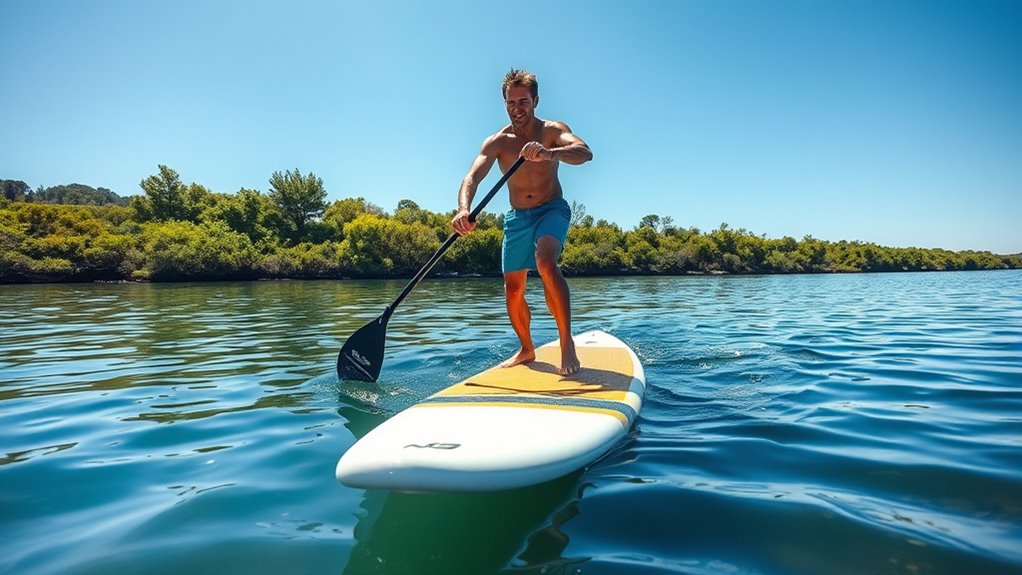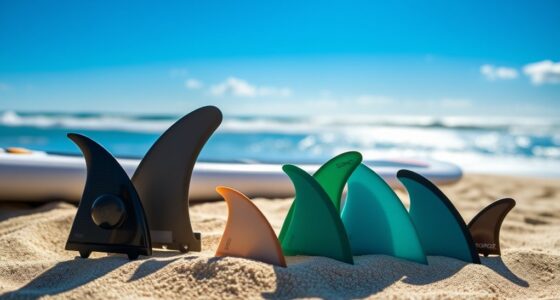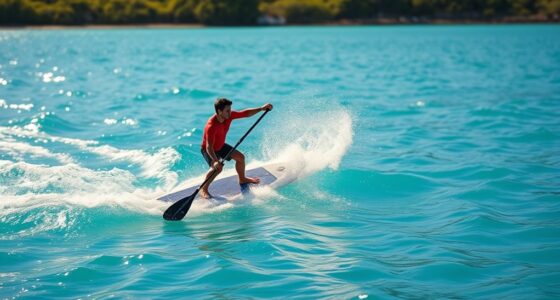The art of cross-stepping on a paddleboard involves shifting your weight smoothly from your stance to move toward the nose or tail of the board. To do this, you focus on maintaining balance, engaging your core, and taking deliberate, controlled steps. Practice on calm water with stable boards, starting near the center and gradually progressing. As you develop control and confidence, this technique becomes more natural—stay with it, and you’ll master more about water navigation.
Key Takeaways
- Cross-stepping enhances balance, mobility, and confidence on the paddleboard by shifting weight smoothly between feet.
- Begin at the center, with feet shoulder-width apart, engaging core muscles for stability before attempting to cross-step.
- Move one foot slowly toward the nose or tail, maintaining even pressure and hip alignment to preserve balance.
- Practice on calm water using controlled, deliberate movements to improve finesse and reduce wobbling.
- Repetition builds muscle memory, making cross-stepping more natural and elevating overall paddleboarding skills.

Cross-stepping on a paddleboard is a skill that can considerably improve your balance and versatility on the water. It’s a technique that requires precise balance techniques and an understanding of paddleboard design. As you progress, you’ll find that mastering cross-stepping transforms your paddling experience, allowing you to move more freely and confidently across the board. The first step is to get comfortable with your current stance and build a solid foundation before attempting to shift your weight. Your paddleboard’s design plays a fundamental role here—broader, more stable boards offer a forgiving platform for practicing this skill, while narrower, more advanced models challenge your balance further.
Once you feel steady, start by positioning yourself at the center of the board, feet shoulder-width apart. Keep your knees slightly bent and engage your core muscles to maintain stability. When you’re ready to cross-step, gently lift one foot and move it toward the nose or tail of the board, depending on where you want to go. The key is to do this slowly and intentionally, using your core to keep your balance. As you shift your weight, focus on maintaining even pressure on both feet and keeping your hips aligned with your shoulders. It’s a subtle but essential aspect of balance techniques—small adjustments make a big difference.
Begin at the center, keep knees bent, and shift weight slowly for balanced cross-stepping.
As you advance, practice crossing your feet smoothly and deliberately, avoiding sudden movements that could cause you to wobble or fall. Remember, your paddleboard’s design influences how easily you can cross-step; wider boards provide more stability, while narrower boards demand more control and finesse. Over time, you’ll learn to read the subtle cues from your board and adjust your stance accordingly. It’s also helpful to practice on calm water where your movements won’t be disrupted by waves or currents, giving you the opportunity to focus solely on your balance techniques. Additionally, choosing a properly designed paddleboard can make a significant difference in your ability to learn and master cross-stepping.
You’ll find that consistency is key. With practice, you’ll develop muscle memory for shifting your weight and adjusting your stance effortlessly. The more you practice cross-stepping, the more natural it will feel, and you’ll be able to navigate your board with greater ease and confidence. Ultimately, understanding your paddleboard’s design and honing your balance techniques are essential for mastering this skill. It’s about patience, awareness, and deliberate movements—qualities that will elevate your paddleboarding to a new level of mastery.
Frequently Asked Questions
What Are the Common Mistakes Beginners Make When Cross-Stepping?
When you’re cross-stepping on a paddleboard, common mistakes include neglecting proper stance and uneven weight distribution. You might step too quickly or lift your back foot too high, causing instability. Instead, focus on maintaining a balanced stance, keeping your knees slightly bent, and shifting your weight smoothly. This helps you stay steady and confident, making your cross-stepping more controlled and effective. Remember, patience and practice improve your technique.
How Do Weather Conditions Affect Cross-Stepping on a Paddleboard?
Weather conditions greatly impact your cross-stepping on a paddleboard. Wind resistance challenges your balance by pushing against you, making it harder to stay steady. Water surface tension can cause the board to feel more unstable, especially in choppier waters. You’ll need to adjust your stance and movements, staying relaxed and aware of these factors, to maintain control and successfully cross-step despite the weather’s influence.
Can Cross-Stepping Improve Overall Paddleboarding Balance?
Did you know that practicing balance exercises can improve your stability by up to 30%? Cross-stepping on a paddleboard definitely boosts your overall balance, making you more confident on the water. It enhances balance enhancement and sharpens coordination skills, which translate into better control and safety. By regularly incorporating cross-stepping, you challenge your muscles and neural pathways, leading to more fluid movement and better performance across all paddleboarding activities.
What Safety Gear Is Recommended for Practicing Cross-Stepping?
When practicing cross-stepping, you should always wear a life jacket for safety, especially in deeper water or if you’re a beginner. A leash helps keep you connected to your board, reducing the risk of losing it if you fall. Both items are essential safety gear, ensuring you stay protected and secure while working on your balance and technique. Prioritize these safety measures for a confident and enjoyable paddleboarding experience.
How Long Does It Typically Take to Master Cross-Stepping?
Mastering cross-stepping on a paddleboard is like waiting for your computer to finish updating—patience is key. Usually, it takes weeks of dedicated balance training and practicing paddleboard technique before you confidently stride across. Some catch on faster, like lightning, while others need months of wobbling and falling. So, don’t rush; enjoy the journey of improving your balance training and paddleboard technique at your own pace.
Conclusion
Mastering cross-stepping on a paddleboard can boost your confidence and enhance your balance. Did you know that nearly 60% of paddleboarders improve their stability considerably after just a few weeks of practice? So, keep practicing and stay patient—each step brings you closer to feeling more comfortable and adventurous on the water. With dedication, you’ll find yourself gliding effortlessly, embracing the freedom and thrill that comes with every successful cross-step.








